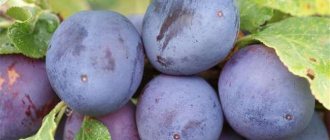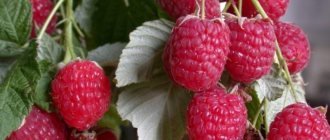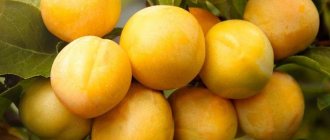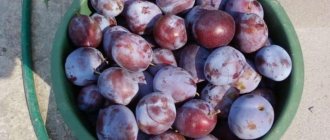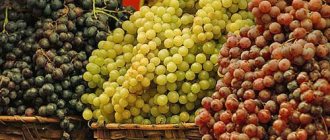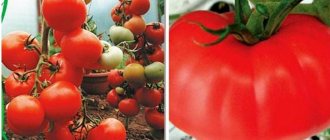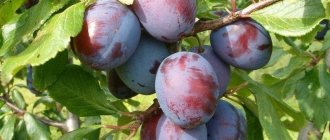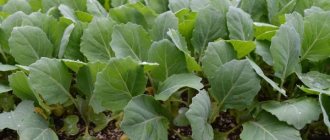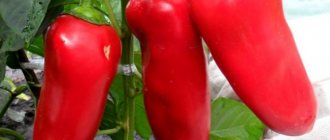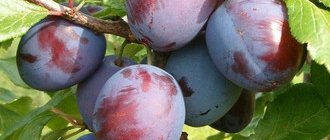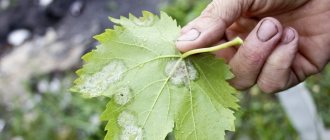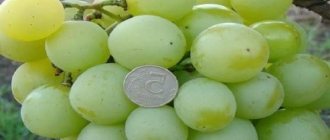General characteristics of varieties
Plum
- occupies a prominent place in Russian gardens. And its adaptability to the most diverse living conditions allowed its varieties to grow successfully over a vast territory from the Caucasus to Siberia and the Far East. There are about two dozen types of plums, but only a few of them “took part” in the formation of the assortment of this crop. The main one in the formation of varieties in the European part of the former USSR is the domestic plum, and in Siberia and the Far East the Chinese plum, and also the prickly thorn, the American plum, and Bessey. But the main one on an industrial scale and in home gardens was the domestic plum.
The greatest importance for Russia and, especially for cultivation in gardens of several hectares, are plum varieties created on the basis of domestic plum.
The value of a plum is determined by its early fruiting, good annual harvest, and the high taste of its fruits. Plums can be boiled, pickled, made into juice and jam. Dried-smoked prunes are made from some varieties.
Early plum varieties: description of varieties
Early varieties
allow you to get tasty fruits early. But they have a more watery taste and little sweetness; they are good both on their own and as a basis for canning for the winter.
Mid-season plum varieties: description of varieties
Mid-ripening plums
extend the season of consumption of plums in time and have a fuller taste.
Late plum varieties: description of varieties
In late varieties of plums
Fruit maturity occurs in the last days of the last month of summer. The fruits themselves are distinguished by the fact that they can remain in special storage facilities for about a month, and those collected in a slightly unripe state can withstand transportation over long distances.
The best self-fertile plum varieties
All varieties of domestic plums are divided into “ self-fertile”
", "
self-sterile
" and "
with partial self-sterility
". For self-fertile plums, there is no need to additionally plant pollinator trees in the garden. Plums with partial self-sterility can produce crops without pollinators, but only the yield is lower than it would have been with pollinators. Fruits of universal use. Among these plums you can find both blue-violet and yellow-fruited varieties. “Orlovskaya Mechta”, “Red Ball”, “Yellow Self-fertile”, Iskra, Hungarian Moscow, “Red Ball”, Memory of Timiryazev and others do not particularly need the presence of “alien” pollen. But self-fertility is not a constant indicator. The same plum variety can consistently show its self-fertility this year, and then be only “partially self-fertile,” and they do not behave the same in different agroclimatic zones.
Variety Renklod green
The fruit is of medium size or quite large, of a constant, almost spherical shape and is intersected by a rather deep and wide groove. The skin is thin, yellowish-green, dark yellow when fully ripe, and the sunny side is dotted with red dots; the entire field of the fruit is covered with a layer of bluish-white bloom. The flesh is greenish-yellow, tender, very juicy, very or very sweet. The stone is medium-sized, ellipsoid, more or less flat, almost free.
Fruit ripens in mid-August.
The tree is cold-resistant, develops strong growth and forms a large, wide crown. It enters the fruiting season early, but it gives birth regularly and generously only in the south.
The fruiting season begins 5-6 years after planting; The harvest increases quickly. In the forest-steppe zone of Ukraine, trees 7-8 years old produce 20-25 kg of fruit, and trees 9-10 years old - 40-50 kg of fruit.
The variety is self-fertile, but to obtain high yields it is advisable to plant it with varieties such as Anna Shpet, Renklod Altana.
Zarechnaya early
This is the most popular early ripening variety of domestic plum. The compact tree has an oval or rounded crown. The branches are dark brown, slightly curved. The leaves are oval, dark green.
At the end of July, large fruits (weighing 35-50 g) of oval or round shape ripen evenly on the tree. The skin is of medium density, dark purple, with an intense waxy coating. The ventral suture is clearly visible on the fruits. The pulp is dense, amber, and easily separated from both the skin and the seed. It is very tender, juicy and pleasant to the taste, the sourness is almost not felt.
This early plum bears fruit for 3-4 years, is not afraid of frost, and the flower buds do not freeze in the spring. The plant is self-sterile, the best pollinating varieties are Volga Beauty, Renclod Tambovsky, Etude.
Variety Hungarian Azhanskaya
A variety of Western European origin. Partially self-fertile, but produces the greatest yields when pollinated by the varieties Renclod Altana and Renclod green .
A medium-sized tree, broadly rounded in shape, with a fairly dense crown. The leaves are oval, slightly concave in the shape of a boat, dark green in color, with a shine.
The variety is not very winter-hardy, so it grows best in the most favorable soil and climatic conditions. In steppe regions it grows well in rich, lower and wetter soils.
Fruiting begins in the 4-5th year. The fruits ripen almost simultaneously, in the second half of August - early September, and do not fall off. They suffer little damage from the codling moth, but suffer from the almond seed eater. With frequent and heavy rainfall during the ripening period, cracks appear on the fruits, after which they are affected by fungal diseases.
Productivity is relatively high. 12-year-old trees produce up to 60 kg of fruit. The fruit weighs 21 g, obovate in shape, with a neck at the base, reddish-violet in color, with rusty spots and a strong waxy coating. The skin is thin, dense, separated from the pulp during ripening. The pulp is greenish-golden, slightly fibrous, tender, good taste, medium juiciness, high preservation, moderate acidity. The stone is small, somewhat flat, rounded towards the top, and in most cases is easily separated from the pulp.
The fruits are suitable for fresh consumption and for processing, especially for compotes, marinades, jams, marmalade, and also for drying (high-quality prunes are obtained from them). Transportable, stored for 1–2 weeks.
Trees in a garden plot are usually planted on the north side to avoid shading the area, but plum trees can also be planted on the east side (the rows should go in the direction from south to north). In this case, the plants will be more protected from northern cold winds. Single trees grow well near the southern walls of country houses, which serve as cover for them.
Kabardian early
The tree grows up to 6 m high and bears fruit 4-5 years after planting. The crown is pyramidal and dense. The plant blooms in early May and begins to bear fruit in July. It does not require pollinating varieties to set fruit. Plums are quite large (weighing 40-45 g), round, with purple-violet hard skin and yellow sweet pulp, which exudes a rich aroma. The fruits are well transported, but are not stored for long.
Sometimes double fruits ripen on the tree, weighing up to 70 g.
The main disadvantage of this plum is that the plant does not tolerate cold winters well. It is recommended to grow it in the southern regions.
Plum varieties popular in Russia
Despite the large number of varieties of plums, there are several most popular varieties. They are especially loved by summer residents.
Zarechnaya early
The crop is grown in the central and black earth regions. It is quite easy to recognize a tree by its slightly curved branches. It begins to bear fruit in the fourth year after planting. This type requires the presence of nearby pollinating trees. Such species as Etude and Volga Beauty are excellent in this capacity.
Zarechnaya early yields harvest already in July
Fruit can be picked already at the end of July. Plums are distinguished by their large size, purple skin color and sweet taste. It is worth noting that they grow quite evenly, so the branches can support the entire harvest. The variety has good frost resistance and tolerates dry periods well. Fruits are stored for a long time and are well transported. Used for jams, preserves and other purposes.
Hungarian Pulkovskaya (Zimnitsa, Pokrovka, Zimovka)
Trees of this species are strong and powerful, growing up to 5 meters. The variety has average resistance to frost and adapts well to new conditions. The crop is self-fertile, but if there are pollinators in the neighborhood, fruiting will be more abundant.
The harvest is harvested after 4 years. The fruits are quite large, the skin is red, the flesh is yellow. Plums are juicy, with a sweet and sour taste, consumed fresh and in preparations.
Souvenir of the East
The plum variety is characterized by a small height and tolerates frost well. However, if grown in cold climates, it is recommended to graft onto more frost-resistant species.
Additional pollination is required to obtain a harvest. The fruits of the variety are large, initially with an orange tint, which gradually changes to dark burgundy. Plums are juicy and have a very pleasant taste.
Note! The plum variety Souvenir of the East can be affected by hole spotting.
Renklod early
This early plum variety was bred in Ukraine, but is also successfully cultivated in cooler regions, since the plant has good winter hardiness.
The plum tree can reach a height of 5 m. At the end of July, large fruits (weighing 40-50 g) of a round shape ripen on it. The skin is dense, yellow, covered with a waxy coating. Sometimes a golden-orange blush appears on it. The pulp is greenish-yellow, juicy and sweet, with a honey taste and aroma.
Renclod early has long been loved by many gardeners due to its very tasty fruits and high yield. However, this variety is self-sterile, so it is necessary to plant plums of one of the varieties nearby: Renklod Karbysheva, Vengerka Donetskaya, Vengerka Donetskaya early.
Variety Hungarian Vanheim
The variety is of Western European origin, self-fertile, drought-resistant, but requires well-fertilized soil.
The trees are powerful, fast-growing, have high winter hardiness, the crown is dense, wide, rounded.
Ripening simultaneously, in mid-August. Productivity is high, 15-20 year old trees produce up to 120 kg of fruit.
The fruits are medium-sized, irregularly oval in shape, with some convexity in the middle, dark blue in color; When fully ripe, they become covered with a thick waxy coating. The skin is thin, dense, sour, and can be easily removed from the fruit. The pulp is dark green, dense, pleasant taste, medium juicy, sugary. The stone is medium, easily separated from the pulp.
The fruits are suitable for fresh consumption and for processing into marmalade and jam. When dried, they produce high-quality prunes and are easily transported. The variety is zoned in the Rostov region and Krasnodar region.
Chachak early
This variety has many synonyms: Chachakskaya best, Chachakskaya nayboliya, Chachakskaya best, etc. The tree has a round-oval crown and reaches a height of 3 m. It blooms in early May, and in the second half of July (3 years after planting) it produces large fruits (about 50-60 g) are ovoid. Their skin is pink-violet, with a blue waxy coating. The pulp of the fruit is dense, green-yellow, juicy, very sweet and aromatic. During transportation, the fruits are not damaged, and can be perfectly stored in the refrigerator for 2-3 weeks without loss of taste and presentation.
This plum is relatively frost-resistant, however, in lowlands on wet soils in winter, young shoots can freeze. In addition, buds and flowers are afraid of return frosts. The variety is self-sterile, so you cannot do without pollinating varieties. Stanley, Nenka, Voloshka, Chachakskaya lepotika, Empress, German, Valor, President are suitable.
Variety Hungarian vulgaris
The fruit, depending on soil conditions, is medium-sized or quite large, irregularly ovoid or ellipsoid in shape; the seam that crosses the length of the fruit is wide and more or less deep. The skin peels off easily, quite dense, black and blue, with white dots and often rusty spots; the entire surface of the fruit is enveloped in a thick layer of matte purple coating. The pulp is greenish, with yellow veins, dense, quite juicy, sweet, with pleasant acidity. The stone is relatively small, with pointed ends and free.
Ripening: the fruits ripen in the second half of September.
The tree has good average vigor, forms a sparse, rather high, almost pyramidal crown, enters the fruiting season early and in nutritious and fairly fresh soil will give birth surprisingly generously.
The variety begins to bear fruit 5-6 years after planting. Productivity is high and almost annual. In the Transnistrian regions, an average of 145 kg is removed from a 13-15 year old tree.
The variety is partially self-fertile. The best pollinators are Anna Shpet , Renklod Altana , Renklod green .
Precocious
This early variety of Chinese plum is characterized by good frost resistance (down to –40°C), the tree is not afraid of return frosts and is able to safely tolerate drought. The crown is spreading, round or fan-shaped. The leaves are light green, medium-sized.
At the end of July - beginning of August, small fruits (weighing 20-27 g) ripen on the tree. They have a dense yellow-red skin with a thin layer of waxy coating. Plums of various colors can ripen on the tree at the same time: from yellow and orange to all shades of red.
The pulp is yellow, juicy, aromatic, sour-sweet, and often difficult to separate from the seed. Productivity is high (about 10 kg per tree), but every 2-3 years there is a poor harvest.
The variety is self-sterile. The best pollinators are the Red Ball, as well as any varieties of Russian plum and hybrid cherry plum.
Blue gift
This mid-season hybrid variety (the tree bears fruit in the second half of August) is self-fertile. However, it has a rather low yield - up to 15 kg per tree. But if you are not going to make numerous preparations from plums or sell fresh fruits, then this medium-sized tree with an oval crown is worth planting on your site.
Blue Dar plum buds safely withstand return spring frosts - and this is the main advantage of the variety. The oval fruits of this plant, although small (weighing up to 20 g), are quite sweet; the stone is easily separated from the dense greenish-yellow pulp. The skin is dark purple with a rich waxy coating. The purpose of the fruit is universal.
Red ball
The tree grows up to 2.5 m high and bears fruit 2-3 years after planting. Hanging branches form a spreading crown of round shape and medium density. Leaves are green, matte. The fruits are formed on annual shoots and bouquet branches at the end of August. The plums are quite large (weighing about 40 g), round. Their dense red skin is covered with a waxy coating of a bluish tint. The pulp is light yellow, very juicy, sweet (with barely noticeable sourness) and aromatic.
This tree is quite winter-hardy: it can withstand frosts down to –35°C. However, spring return frosts can destroy the buds. In addition, the plant can prop up.
The Red Ball plum is self-sterile. The Chinese plum (of any variety), Russian plum, and hybrid cherry plum are best suited for the role of pollinators. But homemade plum is not suitable.
Plum varieties for the Moscow region and central Russia
When choosing a plum variety for central Russia, you should give preference to species with good frost resistance and resistance to pests and diseases of stone fruit trees. Early ripening hybrids are recommended for growing in these regions so that the crop has time to ripen before the first autumn frosts. The best plum varieties for the Moscow region:
- Name: Skoroplodnaya.
- Characteristics: one of the most common early-ripening, productive, but self-sterile varieties for central Russia. Cherry plum, Grossa Di Felicio or Red Ball are suitable as pollinator neighbors. Productivity – 35 kg per tree. The cream is red, with a sweet yellow interior, weighing up to 35 g. The tree is low to 2.5 m, the crown is sparse. Ripening occurs in the first half of August. Frost resistance is good, the tree tolerates temperatures down to -40 ° C. Damaged by pests and diseases to a minor extent.
- Pros: drought resistance, winter hardiness, early ripening.
- Cons: self-sterility.
The yellow-fruited plum variety Yakhontovaya is a breeding success of the authors Kh.K. Enikeev and S.N. Satarova. It was obtained by domestic scientists by crossing the parent forms Eurasia 21 (interspecific) and Smolinka:
- Title: Yakhontovaya.
- Characteristics: productive, early ripening, partially self-fertile. Fruitfulness – 30–40 kg. The cream is yellow in color with a whitish coating and sweet and sour pulp, weighing 30–35 g. The harvest ripens in August. Not afraid of frost. Disease resistance is below average.
- Pros: early ripening, frost resistance, easy removal of seeds from the pulp.
- Cons: the tree grows tall, partial self-fertility.
The Smolinka variety captivated gardeners with its extraordinary dessert taste. Obtained by crossing the varieties Ochakovskaya Yellow and Renklod at the All-Russian Selection and Technological Institute of Plant Growing and Nursery Growing:
- Title: Smolinka.
- Characteristics: high-yielding, early-ripening species, the cream of which is used for preparing dried fruits and prunes. Productivity is 20–25 kg per tree, with a tendency to increase annually. Fruits of dark purple color, 40–45 g, with delicate sourness. Harvest occurs at the end of summer. Winter hardiness is above average, branches quickly recover after freezing. Average disease resistance.
- Pros: large fruit, transportability.
- Cons: self-sterility, branches need support.
Red Ball is a Chinese hybrid bred at the All-Russian Selection and Technology Institute of Horticulture and Nursery Growing. It was obtained by crossing the American Burbank with the Ussuri Red:
- Title: Red Ball.
- Characteristics: frost-resistant, early ripening, partially self-fertile. For a larger harvest, pollinating neighbors are needed. The cream is red in color with a whitish coating, weighing up to 40 g. The yellow pulp is characterized by a sweet and sour taste. Harvest occurs in August. It is not susceptible to clasterosporiasis, but protection from other diseases is required.
- Large fruit, taste, early ripening, frost resistance, transportability.
- Partial self-sterility.
Cherry plum or Russian plum in the Middle Zone. Website "Garden World"
Beloved Mlieva
This early plum has a compact, rounded crown. The fruits ripen on the tree in late July - early August. They are very large (weighing up to 80 g), oval in shape, with a deep abdominal suture. The skin is light green-yellow. The pulp is fibrous, juicy, aromatic, sweet, and easily separated from the seed.
Ripe fruits hang on the tree for a long time and do not fall off. The plant is resistant to disease, but can be attacked by pests, in particular moths.
The variety is self-sterile, the best pollinators are Renclod Altana, Renclod Ulensa, Chachakskaya early.
Which early plum varieties do you prefer?
Variety Hungarian domestic
Domestic Hungarian, or common Hungarian (Hungarian Moldavian, Ugorka vulgaris). An ancient variety, widespread. The trees are vigorous, the crown is round or wide-pyramidal in shape, with dense branching. Frost resistance of shoots and flower buds is high, the variety is resistant to diseases and pests. Due to propagation by seeds and root shoots, it has many different clones, differing in ripening time, size and taste of the fruit.
The variety is self-fertile, and when planted with varieties such as Anna Shpet , Hungarian Italian and Renklod Altana , it produces high yields. It is demanding on soil fertility and moisture; fruit shedding is observed on dry and sandy soils. Fruiting begins in the 5th-6th year.
The fruits ripen almost simultaneously in late August - early September. There is no need to rush into harvesting, as fruits that have ripened on the tree have the best taste (they almost never fall off).
The yield is annual and high, 25-28-year-old trees produce 180 kg. The fruits are stored for 15–25 days and can be transported over long distances.
What characteristics should you look for when choosing a variety?
If none of the varieties described above suits you, you can quite pay attention to plums and cherry plums of folk selection, information about which is not available in the State Varietal Register. It is only important to know what characteristics to pay attention to in order to grow a good plum tree on your site.
The maximum plum yield can be obtained only if the tree is in optimal weather conditions for this variety. In order to ensure that the ratio of light, heat and humidity suits the plants during the periods of flowering and fruiting, breeders develop zoned varieties. Obviously, the plum variety for the Moscow region is not suitable for growing in the Crimea, and the one zoned for the south will not yield a harvest in the middle zone.
The weather conditions in the middle zone are quite harsh for stone fruit crops. Summer in the Moscow region has a moderate number of warm days, winters are cold, the ground freezes to 1.5 meters. The snow cover is formed stable, 20-25 cm. Return frosts can occur until the third ten days of May.
When choosing plum varieties for a garden in the Moscow region and central Russia, you need to take into account the following characteristics:
- frost resistance and winter hardiness - plums must be highly cold-resistant.
- flowering dates - varieties should be selected with a late flowering period - preferably later than mid-May, in order to avoid damage to flowers by return frosts.
- ripening time – by choosing mid- and early-ripening varieties, you can protect the tree from early autumn cold.
- height of the trunk and crown - the number of sunny days in the middle zone rarely exceeds 1500 per year, so it is better to choose a tree of medium height, with a sparse crown.
- self-fertility or the need for a pollinator - in small gardens where it is not possible to plant three or four different varieties, it is better to give preference to self-pollinating varieties (or graft a plum branch of a different variety into the crown of the tree).
- resistance to fungal diseases and pest damage. In arid climates, stone fruits are rarely susceptible to fungal diseases. However, the middle zone is characterized by sufficient rainfall, which provides plants with a good supply of moisture, but creates favorable conditions for the development of diseases.
Large-fruited varieties
Large fruit size is one of the qualities that are valued in dessert plums.
Bogatyrskaya
The tree is of medium height, the variety is very large-fruited, produces fruits weighing up to 35 g. The plums are almost black with a bluish tint and oblong in shape. The taste is very good - sour with a hint of honey.
The yield of the variety increases with the growth of the tree
Characteristics:
- very high harvest per tree - up to 60–80 kg;
- does not bear fruit for 4–5 years after planting;
- completely self-fertile;
- does not get sick and is not afraid of pests;
- ripens by the end of August.
Volgogradskaya
The Volgogradskaya variety needs strict adherence to agricultural technology, otherwise it will not produce large fruits. The plum has a pleasant sweet, slightly sour taste and weighs 50 g.
Fruit color: yellow with extensive pink blush
Characteristics:
- tolerates frost well;
- has good immunity;
- ripens in the second half of August;
- self-pollinating, but responds well to pollinators;
- does not bear fruit for the first 3–4 years.
The older the plum, the higher the yield. The harvest from an adult tree can reach 150 kg.
Top 10 late-ripening plum varieties for the Volgograd region
Experienced gardener Nikolai Galyantin continues to talk about the best varieties of fruit trees. Readers of “Peasant Woman” are already savvy when it comes to pears and apples, now we present to your attention recommendations for choosing late plums.
1. “Anna Shpet”
An old variety, obtained in Germany almost 150 years ago and still has not lost its popularity due to its excellent taste. The authorship belongs to Ludwig Späth - presumably, he named his creation in honor of his kind wife.
For the Lower Volga region, the variety was released in 1947 and has proven itself only on the positive side.
“This is one of the latest varieties to ripen; the fruits are harvested at the end of September,” says Nikolai Galyantin. – Partially self-fertile, with good yield, early fruiting. Pollinators: “giant”, “Volgograd”. Although the variety is considered to have average winter hardiness, it rarely dies in the most unfavorable years. It recovers remarkably well after frost damage.
The tree is medium-sized, with a round-pyramidal crown. The fruits are above average size or large, weighing 40 g, round-oval, blue-violet with a thick waxy coating. The pulp is greenish-yellow, juicy, sweet.
2. Bluefry
An American late-ripening variety (harvested at the end of September), with good winter hardiness, regular and abundant yields and low susceptibility to diseases, it enters the fruiting season early. Developed by crossing the Stanley and President varieties.
– The fruits are oblong, large and very large, weighing 60-70 g, round-oval, black-violet with a strong waxy coating, attractive. The pulp is green-yellow, soft, very juicy, sweet with slight acidity, excellent dessert taste. The best pollinators: “Stanley”, “Anna Shpet”, “president”, says the gardener.
At first, the tree grows strongly, but after fruiting begins, growth weakens. The crown is broadly oval, spreading, and has a tendency to expose branches; in this case, fairly heavy pruning is required.
3. "Victoria"
An ancient English variety, known since the mid-19th century, productive, early-fruiting, self-fertile. One of the European varieties, zoned during the Soviet era, with the best winter hardiness.
“Just recently we ate the last fruits,” says Nikolai Galyantin. – It stores well, about a month, maybe a little more, in the refrigerator, if the fruits are removed a week or a little more before reaching full ripeness.
The tree is characterized by moderately strong growth and forms a small, high-pyramidal crown. Ripening - in the second half of August. The fruit weighs 40-50 g, is ovoid, purple-red in color, with a strong waxy coating.
Among the disadvantages: in wet years it is damaged by fruit rot. Due to high yields, it can be overloaded.
– My variety is grafted onto a medium-sized rootstock. You have to pick it manually, thanks to this the fruits become larger and the taste improves. The main thing is that the tree does not go into winter weakened. This is important - an exhausted tree may freeze, the gardener points out.
4. "Renklod Altana"
Czech variety of medium late ripening. It has long been cultivated not only in our region, but also in Kalmykia and the Astrakhan region.
A minor drawback is that it is self-sterile. The best pollinators are “Anna Shpet”, “Victoria”. Average winter hardiness.
The taste of the fruit is wonderful, the size of the plum is 30-40 g, dark red in color with a purple tint, the distinctive feature is many subcutaneous light dots.
5. “Autumn souvenir”
A variety from the Crimean experimental breeding station, bred by sowing seeds, a clone of the “bluefry” variety with very similar characteristics and excellent taste. The trees are vigorous, fast-growing, with a spherical spreading crown of medium density.
The fruits are large, with an average weight of 47 g, one-dimensional, oval in shape. They dry well when picked earlier. The main color of the fruit is green, the outer color is dark purple. The skin is tender, hairless. The pulp is yellow, rough, fibrous, very sweet. The juice is colorless, sweet.
6. “Hungarian Korneevskaya”
The local variety of Dubovsky selection was named after Roland Viktorovich Korneev, the head of the Dubovsky stronghold.
Average ripening period (late August - early September).
The plum variety “Hungarian Korneevskaya” is self-fertile and begins bearing fruit on medium-sized rootstocks in the third or fourth year after planting.
– Not a spreading, but a strictly pyramidal crown of trees constantly strives upward and requires corrective pruning. We must constantly monitor this until the period of active fruiting. Then the load will be greater and the growth of branches will not be so pronounced,” says the expert.
All “Hungarians” are characterized by a unique fruit shape – oval, tapering towards the stalk. The fruits are large – 30‑35 g.
“The taste is wonderful, which is why the variety is deservedly classified as a dessert variety,” assures Nikolai Galyantin. – It should also be noted that it has good tolerance to low and high temperatures, drought resistance and low susceptibility to disease.
7. "Grand Duke" (or "Great Senia")
– Why are there double names? - I’m interested in Nikolai Nikolaevich.
– If you go into history, you can find 20 names for one variety. When a variety enters a new country, in most cases it is given its own name,” he explains. – And it is already cultivated with this name.
"Grand Duke" is an old English variety. Like “Stanley” and “Hungarian Korneevskaya”, it contains a lot of dry substances, and therefore it is used as dried prunes.
Very productive, the fruits are large, up to 50 g, dark blue, with a waxy coating, elongated in shape.
The crown is compressed, pyramidal. The variety is not designed for critical temperature changes.
8. "Andreevskaya"
Another variety of Dubovsky selection, with a plentiful and regular harvest, good drought resistance, diseases and pests, is weakly affected, self-fertile.
– The variety was formed from sowing the seeds of “Anna Shpet” and largely replicates its qualities, but, as they say, it has gone even further, and its winter hardiness is much higher, which is important in our region. The crown is not susceptible to winter damage even in severe winters.
The tree is above average vigor, with a raised, spherical, medium dense crown. It begins to bear fruit in the 4th-5th year after planting. The fruits are large, weighing 35-40 g, oval, violet-brown, with a depressed apex, with clearly visible subcutaneous white dots, with a strong waxy coating. The pulp is light pink, tender, juicy, sour-sweet, of excellent taste.
9. Stanley (prunes)
A famous variety of American selection, with high and regular yields, high winter hardiness, partially self-fertile, medium-late ripening, zoned in the North Caucasus region in 1983.
– Elongated dark blue fruits, the flesh is dense, and due to the high dry matter content, it dries easily. It never overripes, there are no unsightly pickled fruits. It has very good productivity. Sometimes it requires normalization, otherwise the branches break, you have to take this matter very seriously.
A tree of medium vigor, with a rounded, sparse crown. It begins to bear fruit in the 4th-5th year after planting. The fruits are very large, weighing 50 g, dark purple, obovate, unequal, with a thick waxy coating. The fruits are great for drying.
The variety is self-fertile. With any cross-pollination, fruit sets are very good. One of the disadvantages is that it is not resistant enough to moniliosis.
10. "President"
Old English variety. The tree is vigorous, fast-growing, with an oval-round, dense crown. A late ripening variety (mid-September), universal purpose, with excellent taste.
– The fruits are purple-violet to dark blue, broadly oval in shape, large, weighing 50-70 g. The pulp is yellow, hard, sweet with a slight sourness, easily separated from the stone. The juice is colorless. Only when overripe is it possible for the fruit to fall off. They are stored in the refrigerator for up to three weeks, practically without losing their taste, says Nikolai Galyantin.
Winter hardiness and drought resistance are high, disease damage is very slight. The variety is early-fruiting, high-yielding, and is considered partially self-fertile, but when combined with other varieties of plums, such as “Renklad Altana”, “Bluefry”, yields increase significantly.
By the way
Why doesn't the bone come off?
Among the varietal characteristics they always write about the separation of the pulp from the stone. But is it really that important?
– Some varieties have semi-separable pulp, while others, such as “Azart Premier”, have a pit that drops out when fully ripe. In several dozen varieties of early “Russian plum,” with rare exceptions, the stone is difficult to separate,” says Nikolai Galyantin. “But the fruits are so tasty that I wouldn’t call it a drawback.” In cherries or cherries, the pit also does not separate, but no one attaches any importance to this. But for some reason the requirements for plums are so high.
Marina Zlobina
Plum care in the Moscow region in spring, summer and autumn
Proper care of a plum tree in the Moscow region includes the following points:
- Watering is carried out approximately once a month with normal rainfall, becoming more frequent during the ripening period. The soil should not be over-wetted.
- Fertilizing - in spring it is recommended to add nitrogen fertilizers to the soil. In the summer you can add a little potassium under the trunk, and in the fall you can scatter organic matter under the tree.
- Shortly before the arrival of winter, you need to carry out the last watering of the year, cover the ground with mulch to retain moisture and heat, and then cover the trunk with spruce branches or roofing felt - from frost and rodents. After snowfalls, the snow around the trunk can be compacted.
Pruning plums in the Moscow region
For full development, the plum tree must be pruned regularly.
- After leaf fall, sanitary pruning is recommended for the Moscow region - as for the middle zone.
- Plum shoots older than 2 years are pruned annually by 2/3 of their length.
- You can prune plum trees in the Moscow region in the spring to form a crown. Remove excess branches, leaving only the strongest and most promising shoots.
Planting plums in the Moscow region
The algorithm for planting plums in the Moscow region depends on the specific variety. But there are rules that apply to any variety of plant.
When is the best time to plant plums in the Moscow region?
The best time to plant a plum tree is spring. Even if the seedling is frost-resistant, its roots are still too sensitive to cold and may be damaged during the first winter when planted in autumn. It is optimal to plant in early April, when the frosts are already behind us and the active growing season has not yet begun.
Choosing a landing site
It is recommended to plant the tree on the south side. It is better to choose sandy loam soil with sufficiently deep groundwater.
Selection of plum seedlings for the Moscow region
The main rule when choosing a seedling is that it has strong and healthy roots. Care must be taken to ensure that they are not dry, broken or too lean.
Planting plums in spring in the Moscow region: preparing the pit
The plum tree is very sensitive to soil quality. Therefore, several months before planting a seedling, in the fall before the onset of cold weather, it is customary to prepare a planting hole.
The soil in which the plum will be planted is dug up and the soil is removed approximately 50 - 70 cm deep. Fertilizers are placed inside - compost, rotted manure, superphosphate and ash.
How to plant a plum tree in the spring in the Moscow region
Spring planting of plums in the Moscow region goes like this.
- The pre-prepared hole should be approximately twice as large as the roots of the young plant - both in width and depth.
- The seedling must be carefully lowered into a hole half filled with soil and fertilizers, and covered with soil, compacted properly.
- Immediately after planting, 3 buckets of water are added under the trunk, and then the tree is tied to a support for even growth.
Attention! It is necessary to ensure that the root collar of the tree remains slightly protruding above the soil surface.
What varieties of plums are most suitable for the garden?
Plum is one of the most common garden trees, but it is worth remembering that this plant is extremely whimsical and requires constant care. Properly selected seedlings will delight the gardener with their berries throughout the summer. Plums also make excellent preparations for the winter in the form of compotes, preserves and marmalade. It is better to give preference to plum varieties that are suitable for the area in terms of climatic conditions and soil characteristics on the site.
There are three main groups of plum trees, most of them take root well throughout Russia, but for some reason there is a very small variety of primitive varieties:
- Early ripening and early varieties begin to bear fruit from the end of July to the first ten days of August and are considered the most productive varieties of plums.
- Mid-season varieties - begin to bear fruit from the second decade until the end of August and are considered the most delicious and aromatic varieties of plums; gardeners love to stock up on jam and make tinctures from them.
- Late or very late varieties - begin to bear fruit from late August to mid-September, most varieties are frost-resistant, the fruits are used for canning for the winter.
The best varieties of plums for the garden
